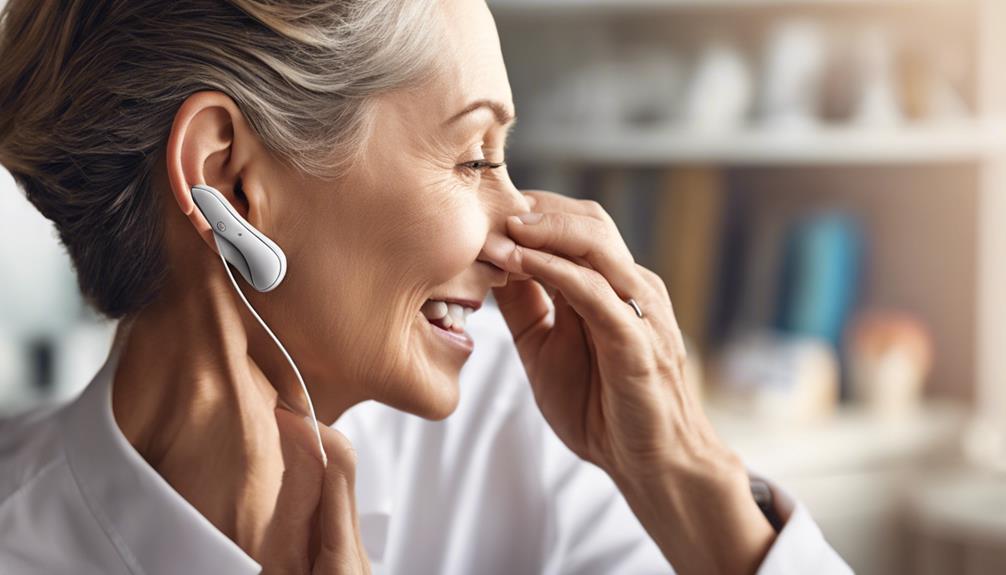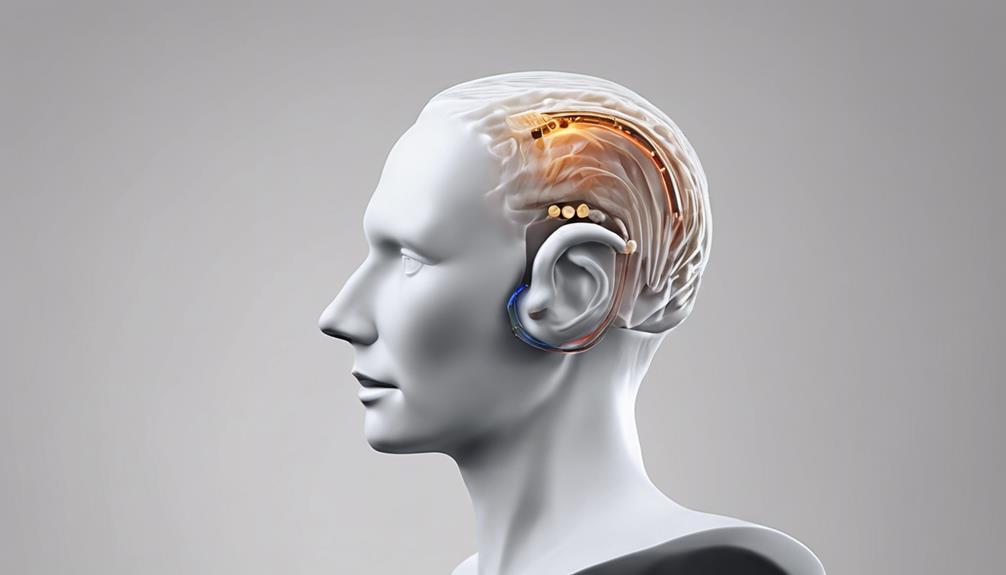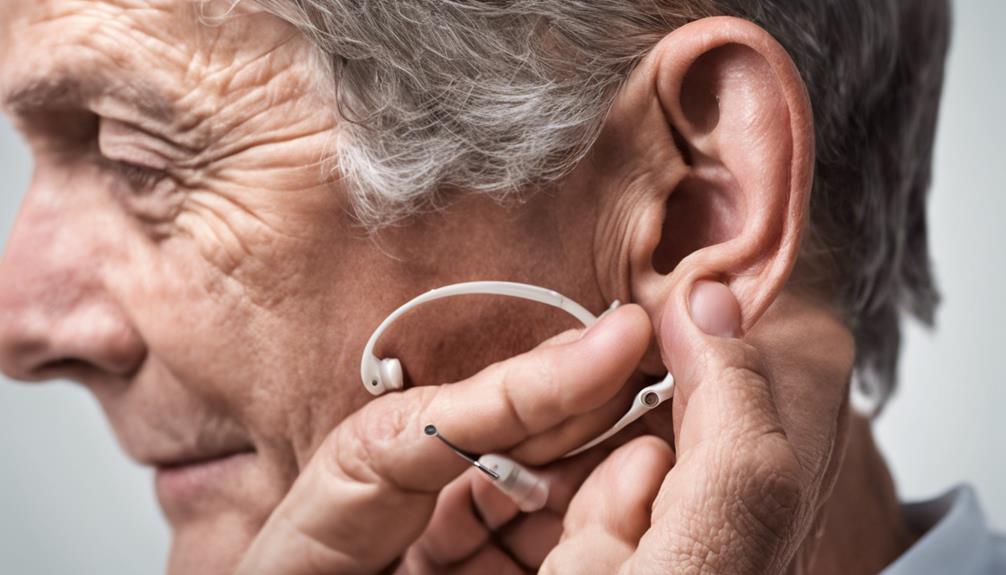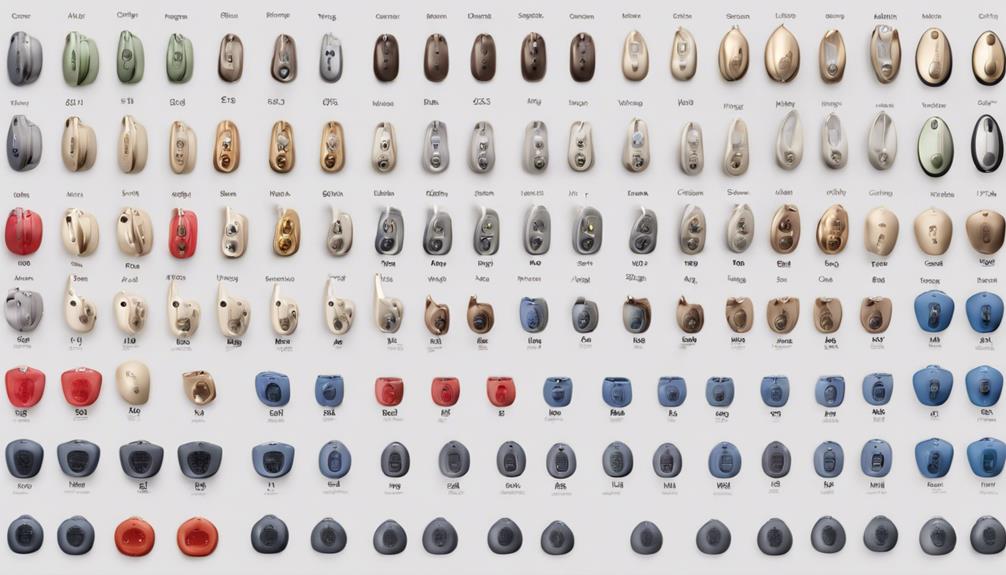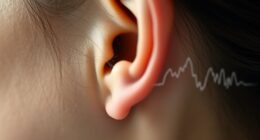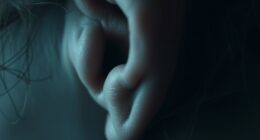Investigating how seven acclaimed figures confidently accept their hearing aids, we delve into a realm where skill and determination eclipse any obstacles encountered. These stars, hailing from various sectors, not only thrive in their professions but also advocate for the awareness of hearing health.
Their journey is a testament to resilience and serves as a beacon for many navigating the realms of hearing impairment. Discover how these iconic figures redefine perceptions and pave the way for a more inclusive society.
Key Takeaways
- Prominent celebrities advocate for hearing health, reducing stigma and raising awareness globally.
- Fashionable hearing aid styles promote inclusivity and modern technology advancements.
- Advocacy efforts highlight the importance of early intervention, regular tests, and proactive care.
- Inspirational stories showcase resilience, acceptance, and empowerment in managing hearing conditions.
Bill Clinton
When it comes to celebrities who've embraced hearing aids, Bill Clinton stands out as a prominent advocate for better hearing health worldwide. Starting to use hearing aids during his second term at 51, Clinton has been a vocal advocate, promoting awareness and supporting early intervention for hearing health.
His efforts extend globally, with trips to Africa to push hearing health initiatives. By openly sharing his experience with hearing aids, Clinton helps reduce the stigma around hearing loss, encouraging others to prioritize their hearing health. His advocacy emphasizes the importance of timely intervention and support for those with hearing impairments.
Clinton's dedication to improving hearing health not only benefits individuals but also raises societal awareness about the significance of addressing hearing issues. Through his actions, he showcases how wearing hearing aids can enhance one's quality of life and contribute to overall well-being.
Jodie Foster

Let's talk about Jodie Foster's hearing journey, her fashionable hearing aid styles, and her advocacy for hearing health.
From confidently wearing an in-the-ear hearing aid to managing her hearing loss to maintaining a successful acting career despite challenges, Jodie Foster inspires many.
Her openness about hearing challenges not only showcases resilience but also helps break down stigmas associated with hearing aids.
Jodie Foster's Hearing Journey
Jodie Foster's resilience and talent shine as she navigates her hearing journey with the aid of an in-the-ear (ITE) hearing device, inspiring many along the way. Despite facing hearing loss and vertigo, Foster has excelled in the entertainment industry, showcasing her determination and skill.
Her openness about these challenges serves as an inspiration for others to embrace their own hearing aids and overcome obstacles with grace. Foster's journey highlights the importance of managing conditions while pursuing one's passions, demonstrating that with perseverance and the right support, individuals can thrive.
Through her experiences, Jodie Foster has shown that hearing impairment doesn't define a person and that success is achievable with hard work and perseverance.
Fashionable Hearing Aid Styles
Navigating through Jodie Foster's hearing journey reveals a stylish and modern approach to embracing hearing aids in the fashion world. Foster confidently opts for an in-the-ear (ITE) hearing aid, showcasing a sleek style that mirrors modern advancements in technology. The comfort and aesthetics of her chosen device blend seamlessly with her appearance, highlighting the integration of hearing aids into daily fashion.
By embracing this chic hearing aid style, Foster sets a trend for personalized and stylish options that cater to individual preferences. Her choice not only promotes inclusivity but also fosters acceptance of hearing devices in the fashion realm.
Jodie Foster's fashionable stance on hearing aids exemplifies how one can make a statement while prioritizing both function and style.
Advocacy for Hearing Health
Advocating for hearing health, Jodie Foster exemplifies resilience and commitment in her advocacy efforts.
- Raising awareness about hearing loss: Foster's openness about her own struggles with hearing loss encourages others to prioritize their hearing health.
- Support for victims of domestic violence: Her advocacy for family justice centers highlights the intersection of hearing health and important social issues.
- Promoting hearing protection: By sharing her journey with hearing aid technology, Foster underscores the importance of regular hearing tests and proper hearing protection.
Jodie Foster's dedication to advocating for hearing health serves as an inspiration for individuals facing similar challenges, emphasizing the significance of proactive care and support within the Deafness advocacy group.
Halle Berry

Halle Berry's hearing journey showcases her resilience in the face of adversity, inspiring others to overcome challenges with grace.
Overcoming the stigma associated with hearing loss, she exemplifies how style and confidence can shine through any circumstance.
Through her advocacy for accessibility, Halle Berry raises awareness and promotes inclusivity for those with hearing impairments.
Halle Berry's Hearing Journey
Triumphing over adversity, a prominent actress lost 80% of her hearing in one ear due to a tragic incident of domestic violence. Halle Berry's journey with hearing loss has been one of resilience and strength. Here are three remarkable aspects of her hearing journey:
- Advocacy: Berry uses her platform to raise awareness about domestic violence and its impact on hearing health.
- Inspiration: Despite her hearing loss, Halle Berry continues to excel in her career, inspiring others facing similar challenges.
- Support: Berry advocates for family justice centers and victims of domestic violence, providing crucial support to those in need.
Through her experiences, Halle Berry shines a light on the importance of supporting and empowering victims of domestic violence.
Overcoming Stigma With Style
Overcoming societal stigmas with grace and style, Halle Berry embraces her hearing aids as a symbol of empowerment and resilience in the face of adversity. Despite losing 80% of hearing in her right ear due to domestic abuse, Berry fearlessly advocates against violence, raising awareness about hearing loss, and breaking stereotypes attached to wearing hearing aids.
Advocacy for Accessibility
Advocating for accessibility and empowerment, Halle Berry shines a light on the impact of domestic violence on hearing loss. Through her advocacy efforts, she raises awareness about the challenges faced by victims of domestic violence and the resulting hearing impairments. Halle Berry's work emphasizes the need for support and resources for those affected by violence-related hearing loss.
- Halle Berry lost 80% of hearing in her right ear due to domestic violence, highlighting the connection between abuse and hearing loss.
- She advocates for family justice centers and victims of domestic violence to bring attention to the impact on hearing.
- Despite facing hearing loss, Halle Berry continues to excel in her career, showcasing resilience and determination.
Pete Townshend

Amidst his legendary musical career, Pete Townshend adeptly manages noise-induced hearing loss with hearing aids in both ears. As a pivotal figure in The Who, Townshend's rock career exposed him to decades of amplified music, contributing to his tinnitus and hearing challenges. Despite these obstacles, he continues to compose and perform, showcasing unwavering passion and resilience in the music industry.
To address his hearing issues, Townshend embraces technology by utilizing hearing aids, setting an inspiring example for others facing similar struggles. By incorporating these devices into his daily life, he demonstrates that hearing loss does not have to hinder one's pursuit of their passions. Townshend's commitment to his craft and his willingness to adapt highlight the importance of seeking solutions to overcome obstacles, inspiring many to persevere in the face of adversity.
| Pete Townshend – Hearing Loss Journey | |||
|---|---|---|---|
| Challenges | Management | Impact | Resilience |
| Noise-induced hearing loss | Hearing aids | Tinnitus | Passion |
Marlee Matlin

Thriving in the entertainment industry despite her deafness, Marlee Matlin utilizes a combination of hearing aids, sign language, and lip-reading to excel in acting and inspire others. Marlee Matlin's journey is a testament to her resilience and determination in breaking barriers for the hearing impaired. Here are three fascinating aspects of Marlee Matlin's inspiring story:
- Advocate for Deaf Awareness: Marlee Matlin isn't only a talented actress but also a vocal advocate for deaf awareness and representation in the media. She uses her platform to raise awareness about the challenges faced by the deaf community and to promote inclusivity in the entertainment industry.
- Award-Winning Actress: Despite her hearing impairment, Marlee Matlin has achieved remarkable success in acting, winning an Academy Award for Best Actress for her role in 'Children of a Lesser God.' Her accolades highlight her exceptional talent and dedication to her craft.
- Inspiration to Many: Marlee Matlin's success story serves as an inspiration to many, showing that with determination and perseverance, individuals with hearing challenges can achieve their dreams. Her journey encourages others to embrace their differences and strive for greatness in their chosen fields.
Holly Hunter

Holly Hunter's journey in the entertainment industry showcases her exceptional talent and resilience, despite facing hearing loss in her left ear due to mumps. Her experience with deafness hasn't hindered her acting career; instead, it has added a unique depth to her performances. Hunter's deafness has allowed her to bring authenticity and intensity to her roles, making her more attuned to subtle nuances in conversations and emotions.
Despite the challenges she faced, Holly Hunter has excelled as an actress and producer, proving that deafness doesn't limit one's potential in the industry. Her dedication to her craft and unwavering resilience serve as an inspiration to many aspiring performers. By embracing her deafness, she hasn't only overcome obstacles but also used them to her advantage, setting an example of strength and authenticity in the world of acting. Holly Hunter's story is a testament to the power of perseverance and the ability to turn adversity into a source of strength.
Adam Savage

Adam Savage, known for his successful career in busting myths and creating innovative projects, proudly wears hearing aids due to otosclerosis, a condition causing limited hearing in his left ear. Embracing his hearing aids as part of his daily life, Savage advocates for acceptance and empowerment among individuals with hearing loss. Here are three intriguing facts about Adam Savage and his advocacy for hearing aid use:
- Normalizing the Conversation: By openly wearing his hearing aids, Adam Savage helps normalize discussions around hearing health and the use of assistive devices, breaking down stigmas associated with hearing loss.
- Inspiring Acceptance: Savage's openness about his hearing aids inspires others with hearing loss to embrace their assistive technology confidently, showing that it shouldn't hinder one's achievements or self-esteem.
- Empowering Through Advocacy: Through his advocacy efforts, Adam Savage empowers individuals with hearing loss by demonstrating that wearing hearing aids is a sign of strength and self-care, encouraging others to seek help and support for their hearing needs.
Frequently Asked Questions
Which Famous People Wear Hearing Aids?
We know famous folks like Bill Clinton, Halle Berry, Marlee Matlin, Pete Townshend, and Adam Savage wear hearing aids. These celebs are inspiring with how they manage hearing loss while excelling in their careers.
Hearing aids aren't just for us regular folks; they help these stars rock their lives and continue doing what they love.
It's cool to see them advocate for hearing aid technology and empower others facing similar challenges.
Why Does Halle Berry Wear a Hearing Aid?
We wear a hearing aid because Halle Berry lost 80% of her hearing in her right ear due to domestic violence. Despite this, she excels in her career and advocates for family justice centers and victims of domestic violence.
Halle Berry's story is a powerful example of triumph over hearing loss, inspiring many to overcome challenges. Through her journey, she sheds light on the impact of domestic violence-related hearing loss, raising awareness and encouraging resilience.
Who Is the Influencer With Hearing Aids?
We know the influencer with hearing aids is Amanda Barrie. She fearlessly embraces her age-related hearing loss, proudly sporting her hearing aids.
Barrie encourages personalizing these devices with glitter and accessories, aiming to shatter stigmas. Her confidence inspires others to embrace their own hearing aids.
Why Does Adam Savage Wear Hearing Aids?
We wear hearing aids to address limited hearing caused by otosclerosis. Our condition affects our ability to hear specific frequencies. Wearing hearing aids proudly normalizes their use.
Advocating for awareness and acceptance, we continue excelling in our careers, inspiring others with creativity and resilience. Despite hearing challenges, we persevere, showing that hearing loss doesn't define us.
Conclusion
As we wrap up our journey through the inspiring stories of these 7 celebrities rocking hearing aids, we can't help but wonder: who else out there's silently overcoming challenges and achieving greatness?
Let's continue to celebrate diversity, embrace assistive devices, and break down stigmas surrounding hearing loss. Together, we can create a more inclusive and supportive world for all.
Who'll be the next celebrity to proudly showcase their hearing aid and inspire us all?


